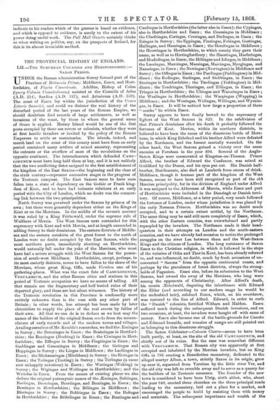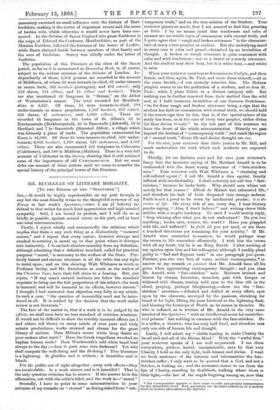THE PROVINCIAL HISTORY OF ENGLAND.
LII.—Tus SUBURBAN COUNTIES AND HERTFORDSHIRE :— SAXON PERIOD.
UNDER the Roman administration Surrey formed part of the Province of Britannia Prima; Middlesex, Essex, and Hert- fordshire, of Flavia Ctesariensis. Adelfius, Bishop of Colon (query Colonia Camulodunum) assisted at the Councils of Arles (A.D. 314), Sardica (A.D. 347), and Ariminum (A.D. 359). The coast of Essex lay within the jurisdiction of the Comes Littoris Saxoniei, and could we disinter the real history of the disturbed period of the last years of the Roman Empire, we should doubtless find records of large settlements, as well as invasions of the coast, by those to whom the general name of Saxon is applied. Mersey Island would be one of the first posts occupied by these sea rovers or colonists, whether they were at first hostile invaders or invited by the policy of the Roman Emperors to settle as mercenaries. The islands, indeed, and marsh land on the coast of this county must have from an early period contained many settlers of mixed ancestry, representing the outcasts or the overflow of most of the revolutions on the opposite continent. The intrenchments which defended CAMU- LODUNUM must have long held them at bay, and it is not unlikely that the two conflicting dates assigned to the first establishment of the kingdom of the East Saxons—the beginning and the close of the sixth century—represent successive stages in the progress of the Teutonic conquest. The East Saxons seem to have soon fallen into a state of dependency on the Gothic or Frank king- dom of Kent, and to have had intimate relations at an early period with the City of Loudon, which no doubt was the connect- ing link between the two principalities.
North Surrey was governed under the Saxons by princes of its own ; but these were generally dependent either on the Kings of Kent or on the Mercians. In the middle of the seventh century it was ruled by a King Frithewald, under the supreme rule of Walfhere of Mercia. The West Saxons next contended for this supremacy with Kent and with Mercia, and at length succeeded in adding Surrey to their dominions. The eastern districts of Middle- sex and the eastern outskirts of the great forest to the north of London were no doubt occupied by the East Saxons, u hile the most northern parts, immediately abutting on Hertfordshire, would naturally fall under the yoke of the Mercians, who must have had a severe struggle with the West Saxons for the posses- sion of south-west Middlesex. Hertfordshire, except, perhaps, in its most easterly districts, seems to have fallen to the share of the Mercians, whose great King, Offs, made Verulam one of his gathering-places. What was the exact fate of CAMULODUNUM, VERULAMIUM, and the other Roman cities and stations in this period of Teutonic occupation we have no means of telling. All that remain are the fragmentary and half buried ruins of their departed glory, and these are but silent witnesses. The history of the Teutonic revolution in this Province is confessedly more entirely unknown than is the case with any other part of Britain ; in other words, less attempt has been made by later chroniclers to supply the place of the real events by fables of their own. All that we can do is to deduce as we best may the names of the holders of the original Saxon marks from the nomen- clature of early records and of the modern towns and villages. Availing ourselves of Mr. Kemble's researches, we find the ./Escingas in Surrey ; the Berecingas in Essex ; the Brahcingas in Hertfordshire; the Boccingas (Bocking) in Essex ; the Ciwingas in Hert-
fordshire; the Effingas in Surrey ; the Fingringas in Essex ; the Geddingas and Guneningas in Middlesex ; the Getingas and Hoppingas in Surrey ; the Lingas in Middlesex ; the Laelliugas in Essex ; the Michaemingas (Mitchham) in Surrey ; the Ricingas in Essex ; the Totingas (Tooting) is Surrey ; the Terlingas (a name now unhappily notorious) in Essex ; the Wocingas (Woking) in Surrey ; the Wigingas and Wellingas in Hertfordshire ; and the Writolas in Essex. From the names of existing places we also deduce the original patronymic names of the Escingas, Balcingas, Baelingas, Beorcingas, Beorlingas, and Beccingas, in Essex ; the Bemingas in Hertfordshire ; the Billingas in Middlesex ; the Blecingas in Surrey ; the Bobbingas in Essex ; the Bofingas in Hertfordshire ; the Brihtlingas in Essex ; the Buntingas and Caedingas in Hertfordshire (the latter also in Essex); the Cypingas, also in Hertfordshire and Essex ; the Cenesingas in Middlesex ; the Claefringas, Coringas, Cresingas, and Dodingas, in Essex ; the Esingas in Surrey ; the Eppingas, Finciugas, Fobingas, Gestiugas, Hallingas, and Hamingss, in Essex ; the Herelingas in Middlesex ; the Heortingas in Hertfordshire, to which county they gave their name, as well as to Hertingfordbury ; the Haestiugas, Haeferingas, and Heafodingas, in Essex; the Hillingas and Islingas, in Middlesex; the Laecingas, Manningas, Maesingas, Maecingas, Mycgingas, and Naessingas, in Essex ; the Newingas (Newington) in Middlesex and Surrey ; the Offingas in Essex ; the Paedingas (Paddington) in Mid- dlesex; the Rodingas, Saelingas, and Stebbingas, in Essex ; the Stocingas in Hertfordshire ; the Taedingas (Teddington) in Mid- dlesex; the Tendringas, Thoringas, and Tillinga.s, in Essex ; the Tringas in Hertfordshire ; the Ultingas and Araceringas in Essex ; the Wealingas in Hertfordshire ; the Waepingas (Wapping) in Middlesex ; and the Weningas, Widingas, Williugas, and Wyrnin- gas, in Essex. It will be noticed how large a proportion of these " marks " lie within Essex.
Surrey appears to have finally bowed to the supremacy of Egbert of the West Saxons in 823. In the subdivision of that Prince's dominions after his death it probably followed the fortunes of Kent. Merton, within its northern districts, is believed to have been the scene of the disastrous battle of Mere- tune, in which King Ethelred and his brother Alfred were defeated by the Northmen, and the former mortally wounded. On the other hand, the West Saxons gained a victory over the same enemies at Farnham in the year 894. Several of the Anglo- Saxon Kings were consecrated at Kingston-on-Thames. Prince Alfred, the brother of Edward the Confessor, was seized at Guildford by the Dams, and his eyes put out. His Danish half- brother, Hardicanute, also died at Lambeth from excess of drink. Middlesex, though it became part of the kingdom of the West Saxons, seems to have been still recognized as part of the old Mercian principality, for in the division of England under Alfred it was assigned to the Alderman of Mercia, while Essex and part- of Hertfordshire were included in the Danelagh or Danish terri- tory. Of course, Middlesex, at a later period, very much followed the fortunes of London, under whose jurisdiction it was placed by the early Norman Princes. Hertfordshire was no doubt much occupied, and to a certain extent settled, by the Northmen. The same thing may be said still more completely of Essex, which, with the other Eastern counties, was overwhelmed and partly repeopled by the invaders. The Northmen made it their head- quarters in their attempts on London and the south-eastern counties, and we have already had occasion to notice the prolonged struggles on the river Lea between them and the West-Saxon Kings and the citizens of London. The long resistance of Saxon Essex to the Christian religion, in which it followed in the steps of the votaries of Odin and Thor in Kent, has been already referred to, and was influenced, no doubt, much by fresh accessions of un- converted " Saxons" from the opposite continental coasts, and perhaps by the prevalence of forest districts, always the strong- holds of Paganism. Essex also, before its submission to the West Saxons, had owned the sway of the Mercians, who long were among the opponents of Christianity. After Alfred's death, his cousin Xthelwald, disputing the inheritance with Edward the Elder (and according to our modern usage he would be the undoubted heir), subdued Essex, which, on his overthrow, was restored to the line of Alfred. Edward, in order to curb the "Danish" colonists, fortified Witham and Maldon. Essex suffered much during the subsequent Danish invasions, and on two occasions, at least, the invaders were bought off with sums of money. Essex also became one of the battle-grounds for Canute and Edmund Ironside, and remains of camps are still pointed out as belonging to this disastrous struggle.
The Saxon Colchester—Colothe Castra—seems to have been built partly, at least, on the site of the old CAMULODUNUM, and chiefly out of its ruins. But the case was somewhat different with VERULAMIUM. That Roman city was apparently at first occupied and inhabited by the Mercian invaders, but on King Offa in 796 erecting a Benedictine monastery, dedicated to the alleged martyr Alban, a town, strictly Saxon in its origin, grew up near it, separated from Verulam by the little river Ver, and the old city was left to crumble away and to serve as a quarry for the builders of its Teutonic successor. The founder of the new town is considered to have been Ulrig, sixth abbot, who, about
the year 948, erected three churches on the three principal roads leading to the monastery, laid out a place for a market, and encouraged the people to build by assisting them with money and materials. The subsequent importance and wealth of the monastery exercised no small influence over the history of Hert- fordshire, making it the centre of important events and the scene of battles with whieh otherwise it would never have been con- nected. In the division of Saxon England into great Earldoms in the reign of Edward the Confessor, Hertfordshire, as part of the Mercian Earldom, followed the fortunes of the house of Leofric, while Essex changed hands between members of that family and the sons of Godwine. Surrey was chiefly under the house of Godwine.
The population of this Province at the close of the Saxon period, as far as it is enumerated in Domesday Book, is, of course, subject to the serious omission of the citizens of London. In- dependently of these, 2,302 persons are recorded in the account of Middlesex, of whom 30 were tenants-in-chief, 62 under-tenants as mesne lords, 343 bordarii (cottagers), and 404 cotarii ; only 112 slaves, 114 villani, and 43 villani and bordarii. There are also mentioned 46 burgesses in " Stanes," on the Abbot of Westminster's manor. The total recorded for Hertford- shire is 4,927. Of these, 55 were tenants-in-chief, 184 under-tenants as mesne proprietors, 1,107 bordarii, 837 cotarii, 550 slaves, 41 sochemarni, and 1,830 villani. There are recorded 46 burgesses in the town of St. Alban's, 52 in Berchamstede (Berkharnpsted), 46 in Esscewelle (Ashwell), 18 in Hertford, and 7 in Stanestede (Stansted Abbot), a village which was formerly a place of trade. The population enumerated for Essex is 16,060. Of these 95 were tenants-in-chief, 520 under- tenants, 8,002 bordarii, 1,768 slaves, 520 sochemarni, and 4,087 villani. There are also enumerated 401 burgesses in Colecestra (Colchester), and 180 in Melduna (Maldon). There is a very full account of Colchester in the Survey, showing that it still retained some of the importance of old CAHULODUNUM. But we must defer our account of these notices until we come to consider the special history of the principal towns of this Province.































 Previous page
Previous page